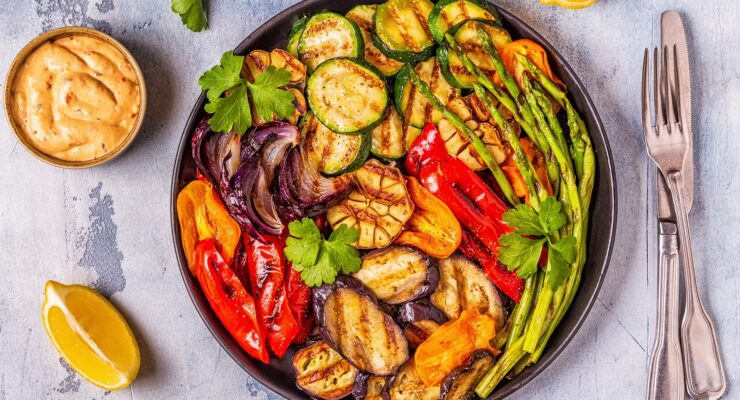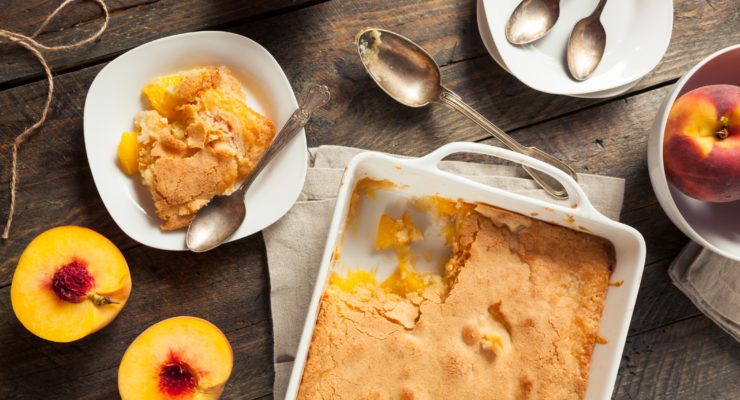7 Delicious Fruits You Never Knew Existed
Article posted in: Diet & Nutrition
You know that fresh fruit is one of the foundations of a healthy diet and it can often satisfy a craving for sweets between meals and at dessert time. Good news: You have lots of choices of fruit to enjoy beyond the old stand-bys, apples and oranges. In fact, here are seven tasty fruits you may never have heard of that are loaded with flavor and nutrients.
STAR FRUIT
Carambola, or star fruit, has light-green to yellow skin and juicy pulp that can be sweet or slightly tart, depending on the variety. It makes a dramatic addition to a dessert tray or salad because when it is sliced the pieces are shaped like stars.
Nutrition highlights: One half-cup serving has 31 calories and 2.8 grams of fiber. The fruit is a good source of vitamin C and potassium, and it’s rich in flavonoids, plant-specific nutrients that help prevent diseases.
Prime time: Winter into early spring.
Try it: You may find a few small seeds inside, but they tend to be tiny and they’re edible. You can eat the fruit raw, make chutney or jam with it, or add it to stir-fries with chicken or seafood.

MANGOSTEEN
Despite its name, mangosteen is not related to mangoes. But this tropical fruit’s heady fragrance and tangy, sweet flavor have made it the most popular fruit in southeast Asia, where it is grown. Inside the fruit’s tough purple outer skin are up to 10 soft and juicy, snow-white triangular segments like those found inside an orange.
Nutrition highlights: You get just 63 calories with a half-cup serving of mangosteen, along with 1.8 grams of fiber and no cholesterol.
Prime time: Summer
Try it: The white seeds inside the fruit can be bitter, so remove those before eating. Mix mangosteen segments with pineapple, papaya, and watermelon for a sweet and refreshing medley.
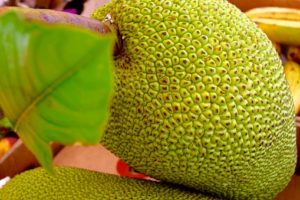
JACKFRUIT
The largest tree-born fruit–some have reached up to 80 pounds–jackfruit is a relative of figs and mulberries with a starchy texture and a flavor that is reminiscent of pineapple, mangoes and bananas. The outer surface is covered with rough nubs, but inside are orange-yellow “bulbs,” which consist of sweet flesh enclosing a smooth, oval, light-brown seed. A single jackfruit may have 50 or more of the edible bulbs inside.
Nutrition highlights: A half-cup serving has 95 calories, 1.5 grams of fiber and substantial amounts of vitamin C and essential minerals, including iron and magnesium. Jackfruit is also a healthy source of micronutrients, such as carotene and lutein.
Prime time: Summer
Try it: Jackfruit segments mixed with banana slices, grated coconut, and honey is a beloved dessert served on festive occasions in India. You can also bake the segments into crunchy chips.

SAPODILLA
The fruit’s brownish outside color may not be the most inviting, but inside the sapodilla you’ll find soft, yellow-orange flesh that tastes like a caramelized pear. The fruit is about the same size as large grapes and may contain up to 10 shiny black seeds inside. The native of Mexico and Central America is sometimes sold as sapota or chikoo.
Nutrition highlights: You get 83 calories in a half-cup serving of sapodilla, along with 5.3 grams of fiber. The fruit is also high in tannins, nutrients that act as antioxidants and reduce inflammation.
Prime time: Winter into early spring
Try it: Unripe sapodilla can be bitter, so be sure the fruit you choose is soft enough that you can indent it with your thumb. Sapodilla adds sweet flavor and bulk to smoothies.
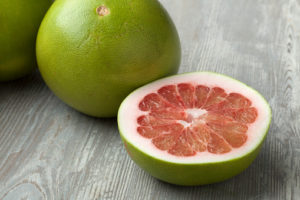
POMELO
A member of the citrus family, pomelo looks like a very large, greenish grapefruit. It has a very thick outer skin, but inside the pinkish segments are juicy and have a balanced sweet and tart flavor. Many find that pomelos are juicier and tastier than grapefruit.
Nutrition highlights: One cup provides 72 calories along with 1.9 grams of fiber, more than 200 percent of your RDA for vitamin C and 410 milligrams of potassium.
Prime time: Winter to early spring
Try it: Peeling the rind and eating the segments fresh is the easy way to enjoy pomelo. You can also squeeze out the juice, freeze it in ice cube trays, and use them to add flavor to refreshing drinks and mocktails.
CHERIMOYA
Commonly called custard apple, cherimoya has a scaly green skin and an oblong shape. Inside you’ll find soft, creamy white flesh and a handful of shiny black seeds. The fruit tastes to many like a cross between pears, bananas, and pineapple, though some people report that the flavor reminds them of bubblegum.
Nutrition highlights: An average-size cherimoya has 176 calories, 7 grams of fiber, and substantial amounts of vitamin C and B vitamins.
Prime time: Late winter into early spring.
Try it: After slicing a cherimoya in half, you can scoop out the flesh with a spoon, discarding the hard seeds as you eat. You can also use the pulp to add creaminess and flavor to pancake batter.
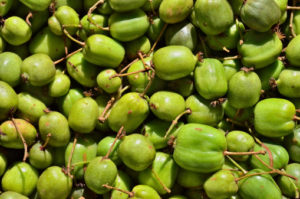
KIWI BERRIES
Also known as hardy kiwi or grape kiwi, these small fruits don’t have fuzzy skin like their larger cousins, but they have a similar sweet-tart taste and soft texture.
Nutrition highlights: A 3.5-ounce serving has 77 calories, no fat, more than 100 percent of your RDA for vitamin C, and 288 milligrams of potassium.
Prime time: Late summer into fall.
Try it: Because kiwi berries have no fibrous skin, you can eat them whole—no peeling necessary.



